Galilee Tour
Kevin Ireland
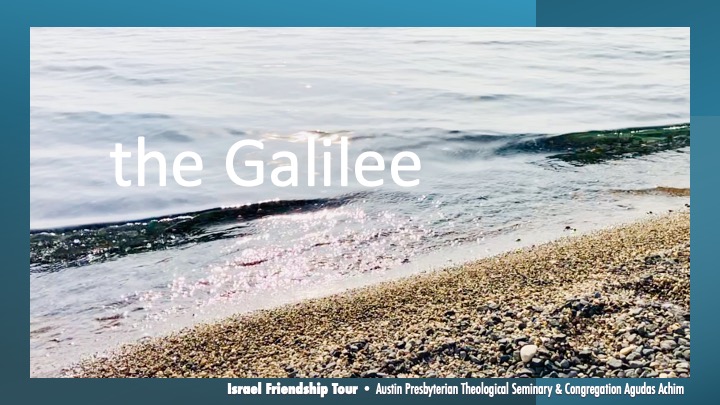
In January 2023 a group from Austin Seminary students and alumni joined with members of Congregation Agudas Achim along with pastors from several denominations travelled together to Israel.
The trip was planned and led by Rabbi Neal Blumhoff and Prof. David Jensen.
Felt most connected to the gospel stories when in the Galilee.
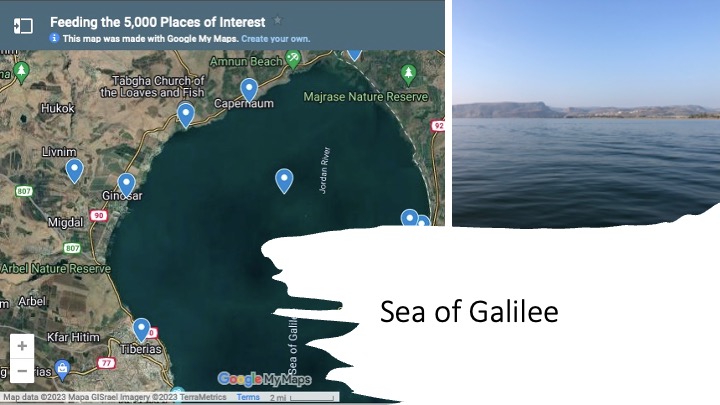
Sea of Galilee – also called Lake Tiberias or Kinneret –
Lowest freshwater lake on Earth and the second-lowest lake in the world (after the Dead Sea) –
Approx. 700 feet below sea level
Fed by Jordan river and underground springs
Jesus’ stomping grounds (Evangelical Triangle)
• Calling first disciples (Mk 1:16-20)
• Sermon on the Mount (Mt 5:1)
• Healing of the hermoraging woman (Mk 5:24-34)
• Healing of the leper (Matt 8:1-4)
• Miracle of Multiplication
• Jesus walks on water (Mk 6:45-52)
• Jesus preaching and teaching in Capernaum (Jn 6)
• Woes to the unrepentant cities (Luk 10:13-16)
• Meeting Peter and companions after the resurrection (John 21:1)
• Last appearance of Jesus in Galilee (Matt 28:16-20)
Galilee Tour
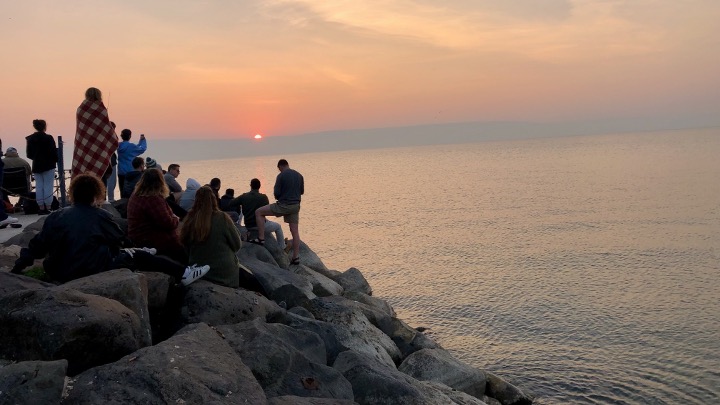
Stayed at Ginosar – kibbutz in the Plain of Ginosar on the western shore of the Sea of Galilee just north of Tiberias
• in Matthew = Gennesaet
• founded by Socialist Zionists in 1937
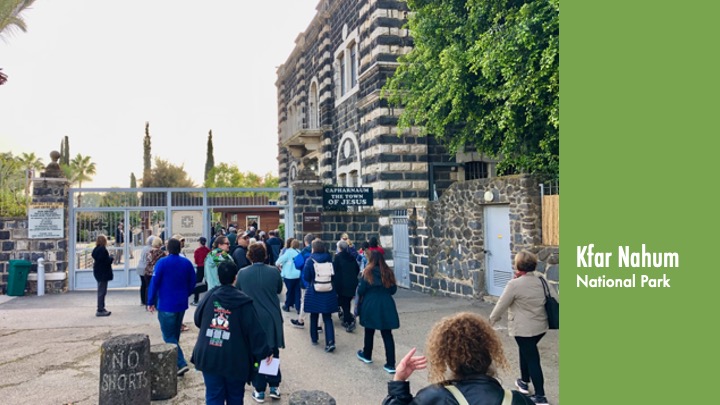
Ancient city of Capernaum is now a National Park
• Kfar Nahm (Nahum’s village/village of comfort) = Capernaum – fishing village on norther Sea of Galilee – pop. 1,500 – inhabited continuously since 2nd cent. BCE
• One of 20 cities given by King Solomon in the Galilee – (1 Kgs 9:11)
• City cited in all four gospels (Matt 4:13, 8:5, 11:23, 17:24, Mark 1:21, 2:1, 9:33, Luke 4:23, 31, 7:1 10:15, John 2:12, 4:46, 6:17, 24, 59
• major trade route from Israel to Mesopotamia.
• hometown of the Matthew the tax collector – close to Bethsaida hometown of Peter, Andrew, James, and John
• Franciscans purchase land in 19th century
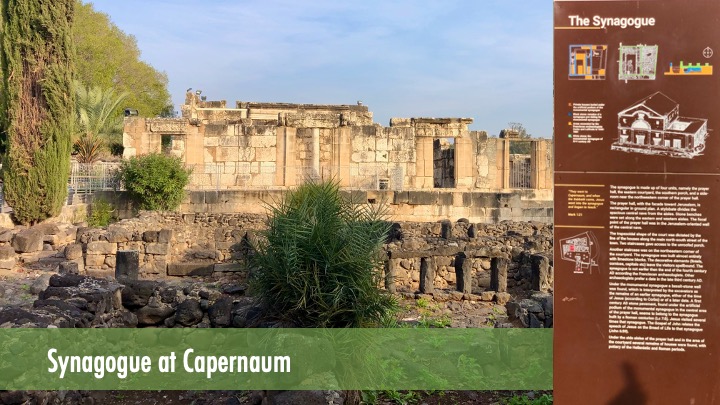
“They went to Capernaum, and when the Sabbath came, Jesus went into the synagogue and began to teach.” Mk 1:21
• American biblical archaeologist Dr. Edward Robinson came across ruins in 1838 that surpassed anything he had seen in Palestine
• 1866 English archaeologist Charles Wilson - identified them as the Synagogue of Capernaum
• 1905 excavations began in earnest, overseen by Baldi until his death in 1926.
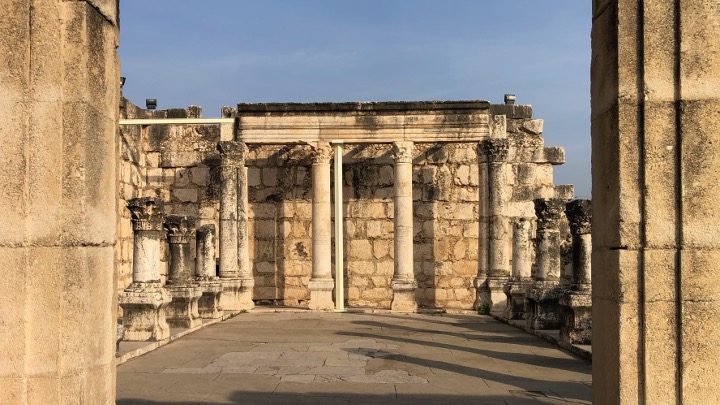
• One of the oldest synagogues in the world still standing
• Built in 4th or 5th century almost entirely of white blocks of limestone brought from distant quarries (Arbel region near Golan Heights to the north)
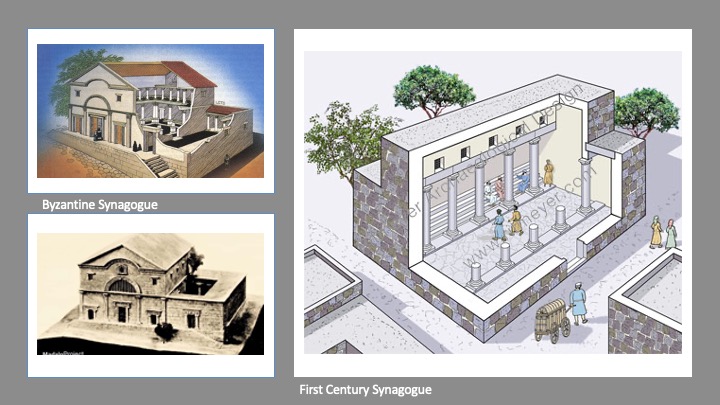
Galilee Tour
Byzantine Temple
• Synagogue was made up of four units – prayer hall, the eastern courtyard, the southern porch, and the side room near the northwestern corner of the prayer hall.
• Internal walls were covered with painted plaster and fine stucco work found during the excavations
• believed to have been an upper floor reserved for women – accessed by an external staircase
• Under the synagogue a basalt-stone wall was found, which is interpreted by the excavators as the remains of an earlier synagogue – believed to have been the synagogue that Jesus attended and believed to been built by a Roman centurion. (Lk 7)
• Surrounded by houses
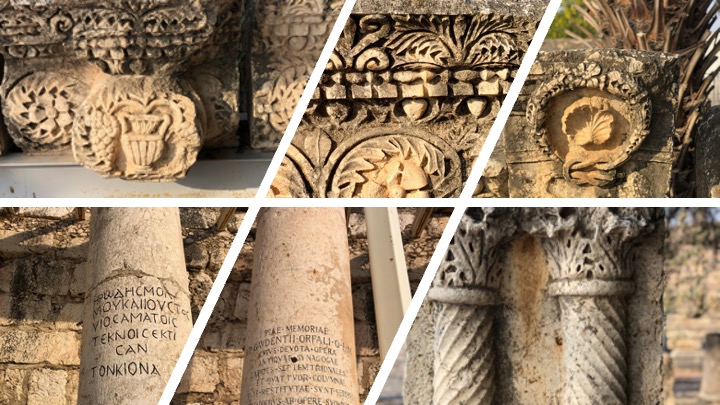
Incredibly well-preserved stonework spans centuries
Vases filled with grapes and leaves are typical of the Jewish harvest festival of Sukkot – festival of booths/tents – Makeshift huts (sukkas) are built and dined in, recalling the Book of Exodus and the time in the wilderness
Inscription in columns for benefactors of the project (like today)
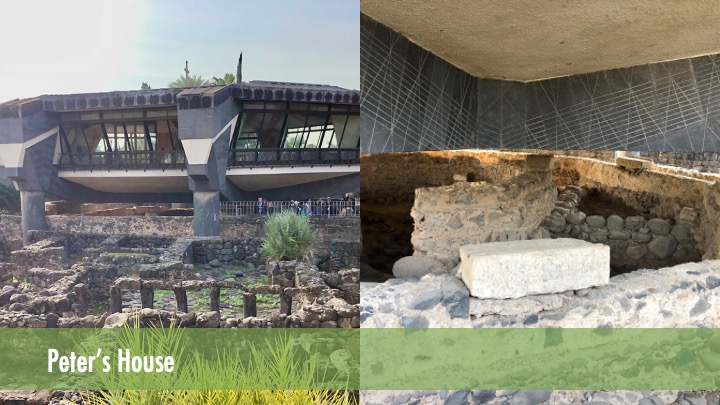
Galilee Tour
Ruins of Peter’s house where Jesus healed Peter’s mother-in-law – next to synagogue
• 1968 – began excavations on the house of Peter and the older Synagogue below the 5th century “monumental” Synagogue
• consisted of a few small rooms clustered around two open courtyards - especially spaciously large room 25’ per side
• Beginning in the latter half of the 1st century AD this house was better taken care of then others
• rough walls of the main room were reworked with care and plastered
• no domestic ceramics/dishes found (like in most homes) instead lamps and large storage jars
• suggests that the place was not used as a residence but as a communal gathering place.
• Perhaps one of the first house churches domus ecclesiae (recently scholars have challenged)
• 4th century – thick walls built surrounding the structure nearly 100’ long and over 7’ tall.
• Remained for 100 years until replaced by a larger bacilica
• 5th century church – Octagonal – (why 8 sides – day of the resurrection/first day of the new creation)
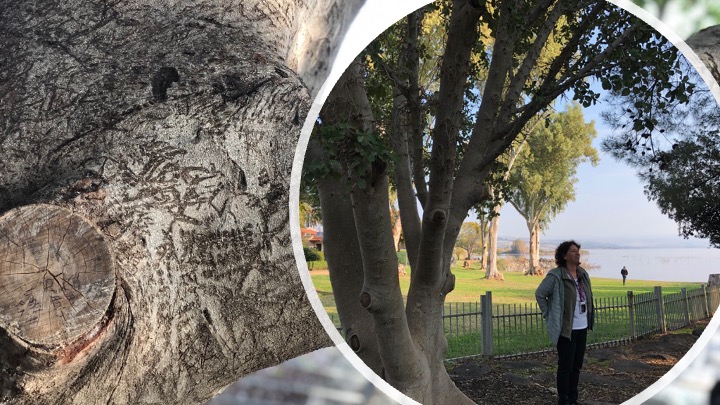
Sycamore Tree,
• related to the Mulberry Tree.
• Israel’s sycamore (ficus sycomorus) is not related at all to the tree in the United States of the same common name (platanus occidentalis).
• In Genesis 3:7 it says: “Then the eyes of both of them were opened, and they realized they were naked; so they sewed fig leaves together and made coverings for themselves.” Scientists, archaeologists, and religious scholars all seem to agree that this is the most likely species of the Fig Tree that the book of Genesis could have been referring to. It is the only species of the Fig Tree that is native to the Middle East.
• also the only Sycamore Tree that has larger than normal leaves.
• In ancient Hebraic writings, the Sycamore Tree symbolized “regeneration.”
• When transplanting a Sycamore Tree, you must do it quickly, as the roots dry out very rapidly
• Sycamore Tree has an amazing ability to regenerate itself. If the sand covers one of its branches, it will establish new roots and reproduce a whole new tree.
• During ancient times, the Sycamore tree in Israel was considered extremely important.
• David appointed a special overseer for the Olive and Sycamore Trees (1 Chronicle 27:28).
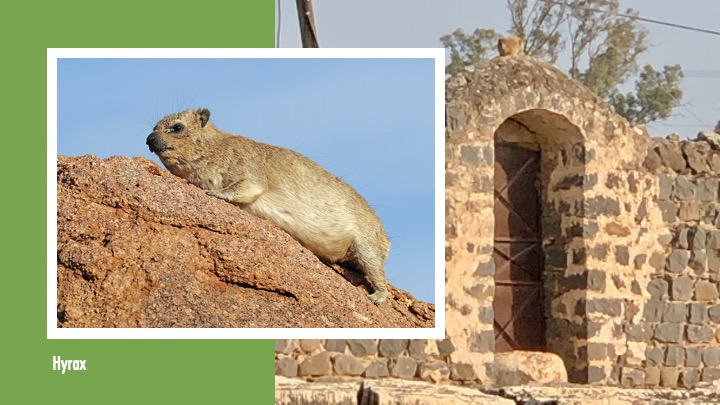
Hyrax
- native to Africa and Middle East
- related to elephants
- common ancestor 26 million years ago
Galilee Tour
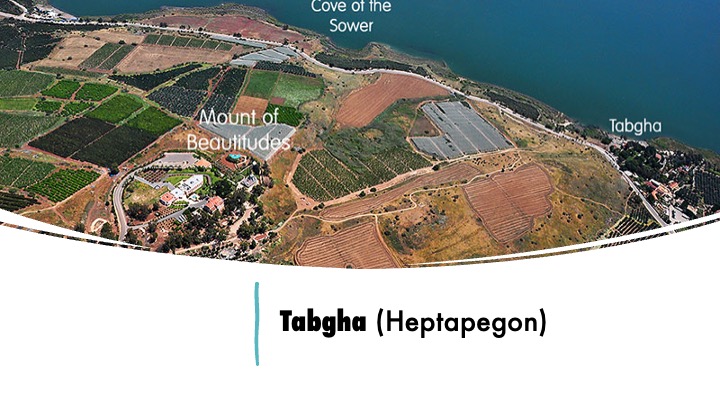
Many names for same place
Biblical Names – Magadam (Mt. 15:39) “The Waters of Good Fortune,” Dalmanutha (Mk 8:10) “The Region of His Stay”
Arabic/Hebrew – al-Tabigha or Tabgha – Ein Sheva ‘”spring of seven”
Byzantine Heptapegon
in ancient times the water from the natural springs was collected in water towers and sent via aqueducts to nearby farmlands to irrigate fields
basalt stone font and oil presses in front
• The village population was expelled in 1948 during Operation Broom.
• It is traditionally accepted as the place of the miracle of the multiplication of the loaves and fishes (Mark 6:30-46)
• and the fourth resurrection appearance of Jesus (John 21:1-24) after his Crucifixion.
Jesus stories
Matt 14:13-21 – “when he went ashore, he saw a great crowd; and he had compassion of them and cured their sick.
Matt 15:32-39 – “And all of them ate and were filled; and they took up the broken pieces left over, seven baskets full
Mark 6:30-44 – “But he answered them, “You give them something to eat.”
Mark 8:1-10 – “His disciples replied, “How can one feed these people with bread here in the desert.”
Luke 9:10-17 – “And taking fie loaves and the two fish, he looked up to heaven, and blessed and broke them, and gave them to the disciples to set before the crowd.”
John 6:1-15 “There is a boy here who has five barley loaves and two fish. But what are they among so many people?
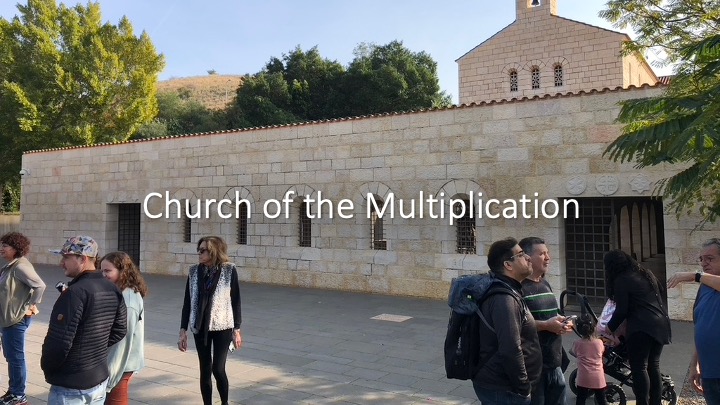
RC church – on the site of two former churches
• The earliest building at Tabgha was a small chapel built in the 4th century A.D. (around 350) by the Jewish convert to Christianity, Joseph of Tiberias.
• According to Epiphanius, Joseph was a contemporary of Emperor Constantine, a Rabbinical scholar, member of the Sanhedrin and a disciple of Hillel II.
• Following his conversion, Emperor Constantine gave him the rank of count and gave him permission to build churches in the Galilee, specifically, in Jewish towns which didn't yet have a Christian community,
• the Galilee including the Sea of Galilee, was an area with a Jewish majority.
• probably the shrine described by the pilgrim Egeria at the end of the 4th century.
• Since 1939 the property run by Benedictine order as a daughter-house of the Dormiton Abbey in Jerusalem
• the current church inaugurated in 1984 built on same floor plan as the 5th-centery Byzantine church - some of the black-basalt walls survived and are visible.
Galilee Tour
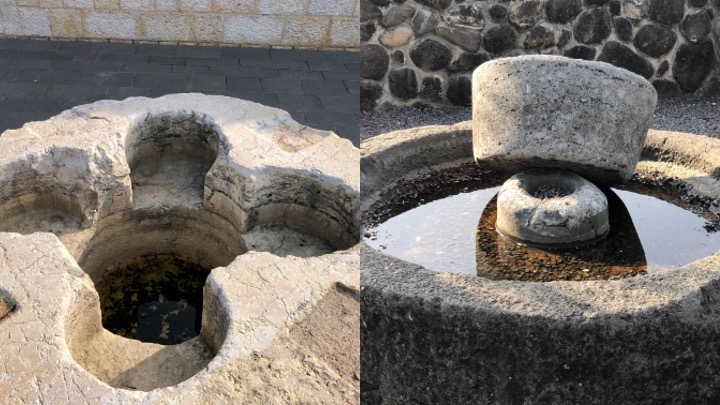
Any guesses as to what these are?
- Basalt-made oil press (on right) and baptismal font (on left).
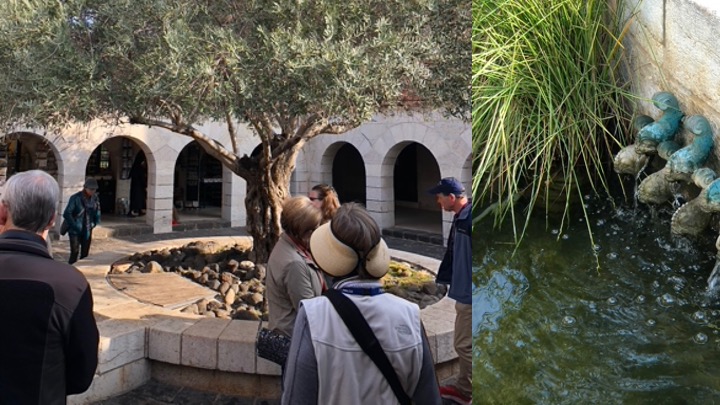
Olive tree and fountain with 7 fish (7 springs) in courtyard
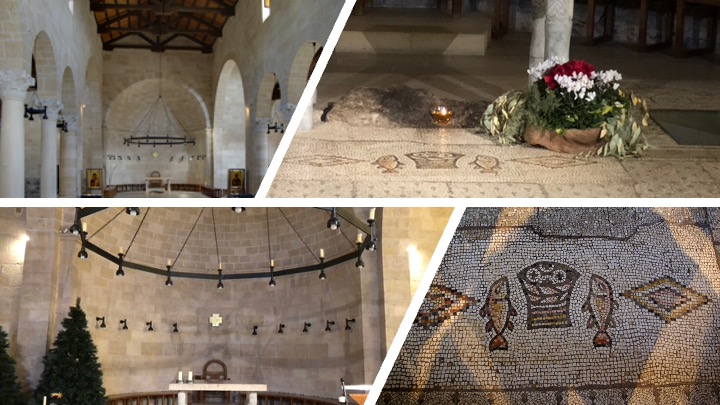
Torn down in 480 and a bigger chapel was built by Martyrius of Jerusalem, Patriarch of Jerusalem from 478 to 486.
The mosaic of the fish and loaves is laid next to a large rock, which has caused some New Testament scholars to speculate that the builders of the original church believed that Jesus stood on this rock when he blessed the fish and loaves just before the feeding of the crowd who had come to hear him.
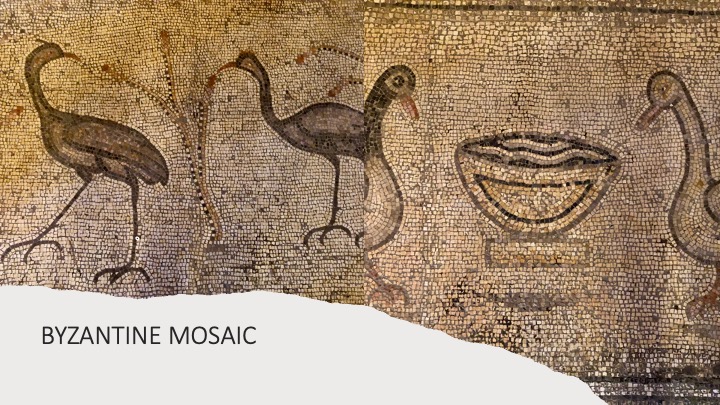
Martyrius was Egyptian by origin, and this may be the reason why the floor of his chapel was covered with a beautiful Nile mosaic, a style of art popular in the Byzantine time, describing Nilotic landscape and the fest of the Nile.
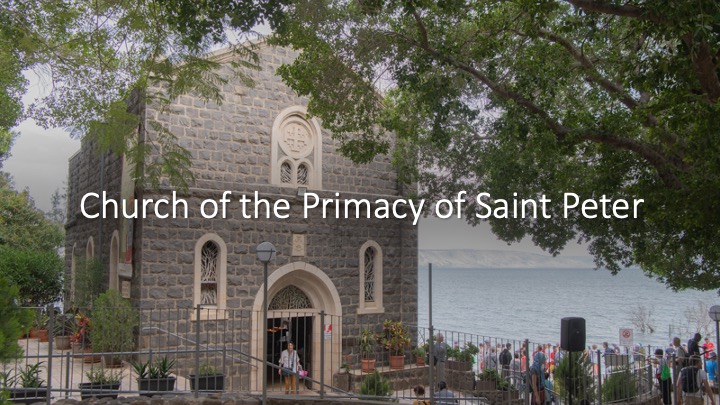
Primacy of Saint Peter
• Franciscan Chapel built in 1933 on the site where Jesus is believed to have reinstated Peter as the head of the Apostles
• parts of the current structure derive from a 4th century church still visible at the base of the walls
• Called the “Place of the Coals” in the 9th century – referring to Jesus’ beach breakfast
• the original church survived longer than any other in the area (destroyed in 1263)
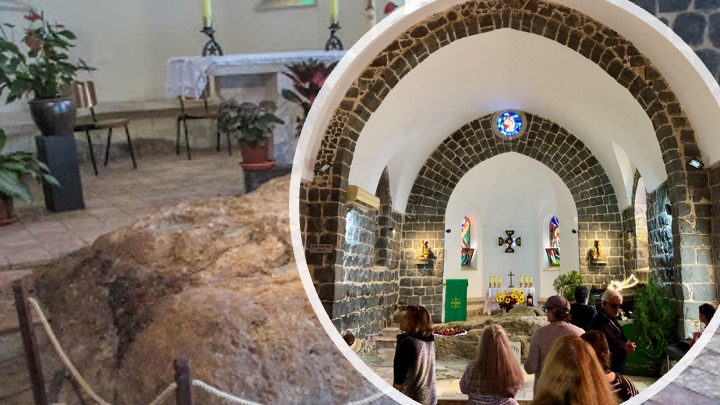
Large limestone rock where tradition holds that Jesus served the disciples the breakfast of fish and bread.
Known as the Mensa Christi – Latin for “table of Christ”
Also where Jesus told Peter three times to feed his sheep
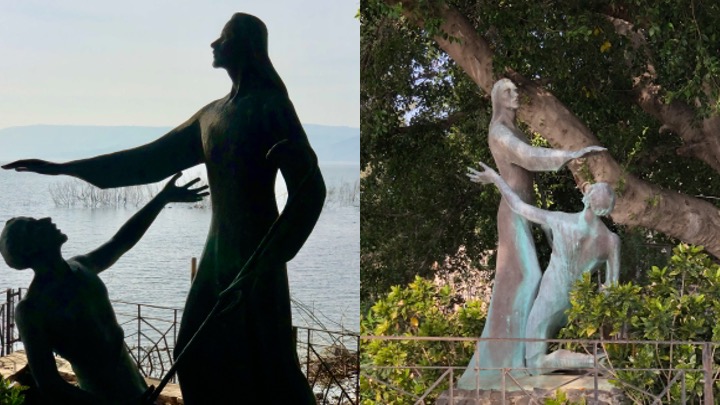
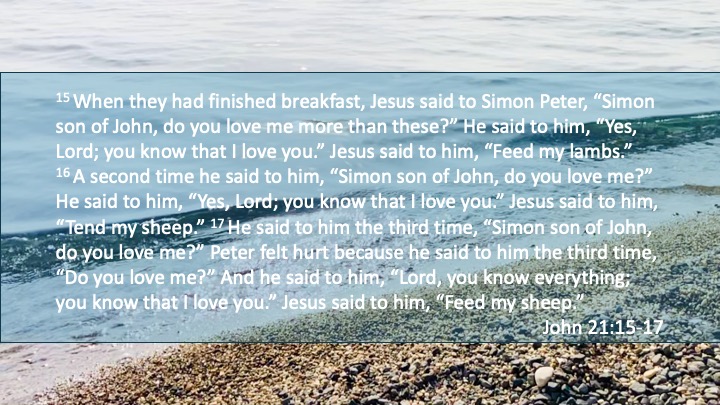
15 When they had finished breakfast, Jesus said to Simon Peter, “Simon son of John, do you love me more than these?” He said to him, “Yes, Lord; you know that I love you.” Jesus said to him, “Feed my lambs.” 16 A second time he said to him, “Simon son of John, do you love me?” He said to him, “Yes, Lord; you know that I love you.” Jesus said to him, “Tend my sheep.” 17 He said to him the third time, “Simon son of John, do you love me?” Peter felt hurt because he said to him the third time, “Do you love me?” And he said to him, “Lord, you know everything; you know that I love you.” Jesus said to him, “Feed my sheep.”
John 21:15-17
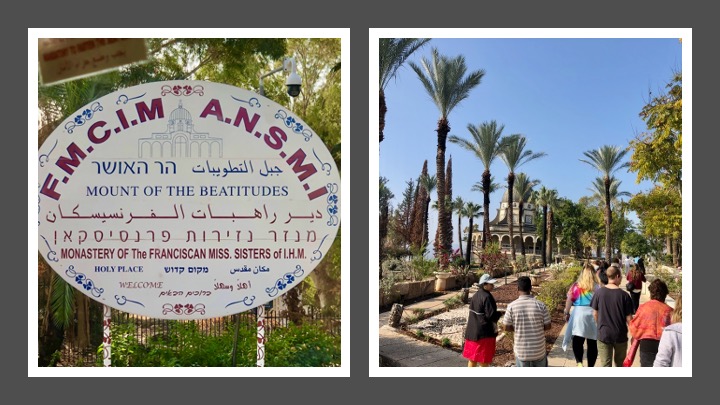
The Church of the Beatitudes (Hebrew: כנסיית הר האושר) is a Roman Catholic church located on the Mount of Beatitudes by the Sea of Galilee near Tabgha and Capernaum in Israel.
The church is located on a small hill overlooking the Sea of Galilee, the traditional "mount" on which Jesus delivered the Sermon on the Mount.
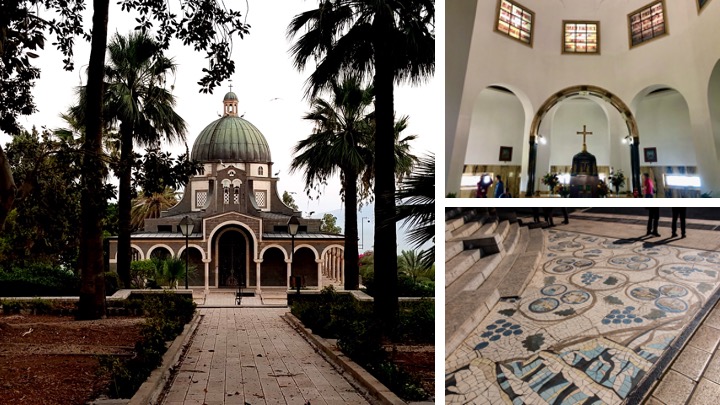
• The current church sits uphill from the ruins of a small Byzantine-era church dating to the late 4th century, which contains a rock-cut cistern beneath it and the remains of a small monastery to its southeast.
• Christian pilgrims are known to have commemorated this approximate site since at least the 4th century.
• In her itinerary of the Holy Land, after describing the Church of the Loaves and Fishes,
• the pilgrim Egeria (ca. 381 CE) writes, "Near there on a mountain is the cave to which the Savior climbed and spoke the Beatitudes."
• Both Popes Paul VI and John Paul II celebrated Mass at the church during their pastoral visits to the Holy Land.[2]
• The floor plan is octagonal, the eight sides representing the eight Beatitudes.
• The church is Neo-Byzantine in style with a marble veneer casing the lower interior walls and gold mosaic in the dome.
• Around the altar are mosaic symbols on the pavement representing Justice, Prudence, Fortitude, Temperance, Faith, Hope, and Charity.
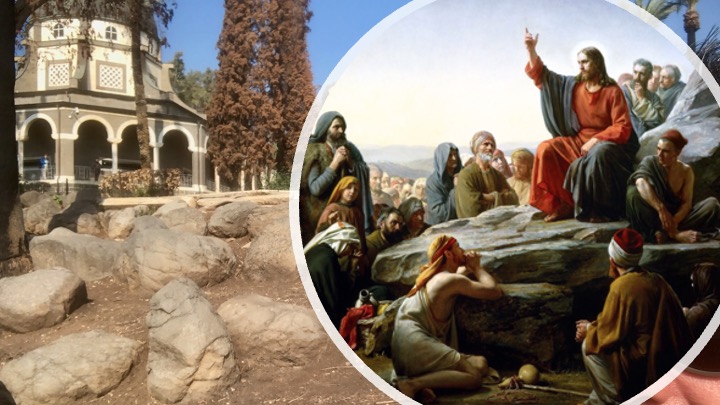
Jerome Murphy-O'Connor describes the selection of the site : "It was perhaps inevitable that this well-watered area with its shade trees on the shore of the Sea of Galilee, where Byzantine pilgrims ate their picnics, should have been identified as the location of two episodes involving the consumption of food, the multiplication of the loaves and fishes and the conferral on Peter of the responsibility of leadership after a fish breakfast. Then it became convenient to localize the Sermon of the Mount on the small hill nearby." (The Holy Land: An Oxford Archaeological Guide from Earliest Times to 1700, p. 277)
Regardless of whether this is the very spot, the Church of the Beatitudes stands in the general area and in a very similar setting to where Jesus would have stood as he delivered his famous sermon. As Murphy-O'Connor puts it, "from here one can see virtually all the places in which Jesus lived and worked" (p. 280).
Painting from Carl Bloch 1877
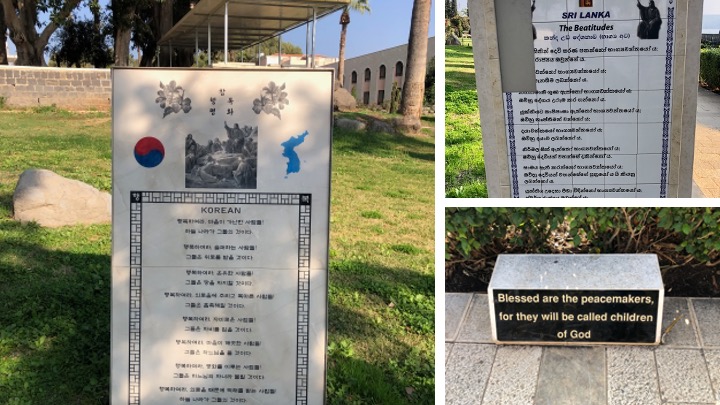
Signs with Beatitudes in different languages
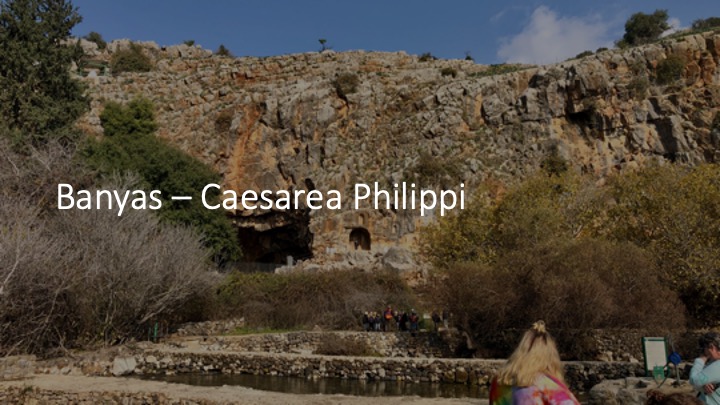
• Alexander the Great conquered area in 3rd cent. BCE
• Natural beauty of site with cave and springs that welled up made it ideal for worship
• Sanctified the cave dedicating it to Pan – god of forest and shepherds
• Arabic name, Banyas comes from earlier name Panyas (for Pan)
• Pan cave
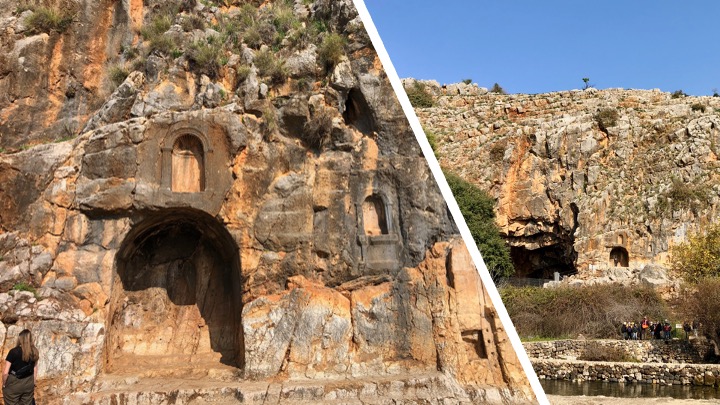
• Rome incorporated area into Herod’s kingdom in the last part of the first century BCE
• Herod built a temple near the springs and named it for the Roman emperor Augustus
• Herod’s son Philippus ruled from here calling the town Caesarea Phlippi
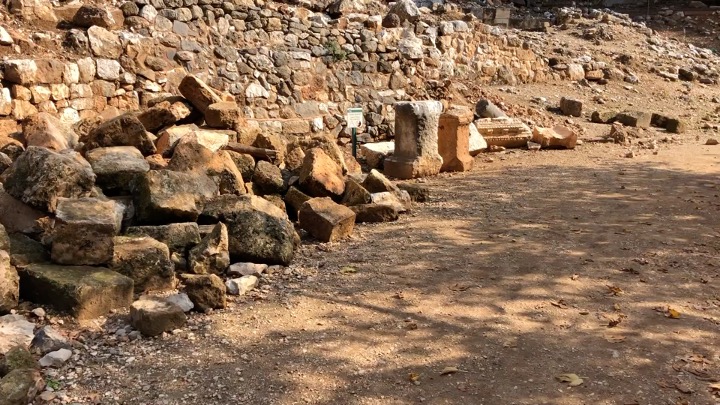
• 1st cent. BCE–Paved courtyard and path
• temples with statues, including the temple of Augustus, and rock-carved niches and Greek inscriptions were carved
• indicating worship of other gods besides pan
• continued pagan activity well into the Christian Byzantine era
• archaeological excavation by Israel Antiquities Authority found remains of temples and cult-courts, scriptures, alters, and inscription – people bringing food, ceramic and glass vessels, alters and statuettes to Pan and the Nymphs along with Zeus, Asclepius, Athena, Hera, Aphrodite, Artemis, Dionysus, and Aris
• eatern end of sanctuary near the “Sacred Forest,” has two structures associated with a unique cult of dancing goats – one at where they danced and one where they were buried
An artificial cave was quarried in the cliff-face opposite the courtyard and there was a statue of Pan.
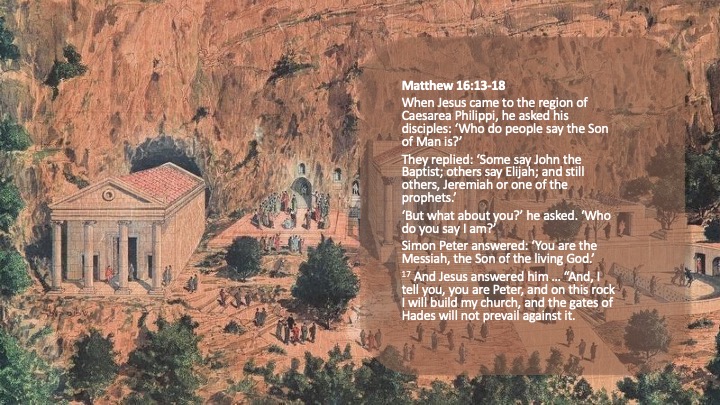
Artists rendering of what Caesarea Philippi it might have looked like – Temple of Pan and the Dancing Goats
Matthew 16:13-18
When Jesus came to the region of Caesarea Philippi, he asked his disciples: ‘Who do people say the Son of Man is?’
They replied: ‘Some say John the Baptist; others say Elijah; and still others, Jeremiah or one of the prophets.’
‘But what about you?’ he asked. ‘Who do you say I am?’
Simon Peter answered: ‘You are the Messiah, the Son of the living God.’
17 And Jesus answered him … “And, I tell you, you are Peter, and on this rock I will build my church, and the gates of Hades will not prevail against it.